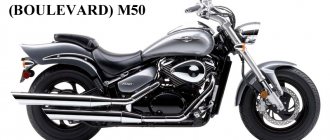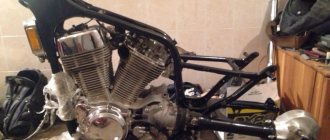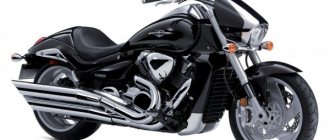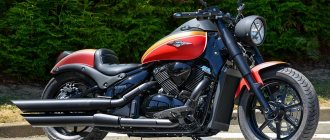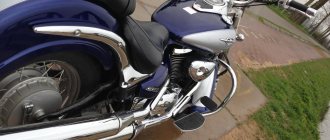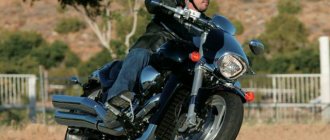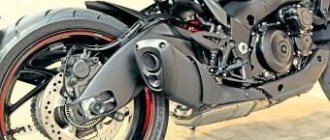| Suzuki VL800 Intruder Volusia (2001-2004) | Suzuki Intruder C800 / Boulevard C50 (2005+) | Suzuki Intruder C800C / Boulevard C50C (2006-2014) | Suzuki Boulevard C50T (2006+) |
Cruiser model Suzuki VL800 Intruder (Volusia)
appeared in 2001 as a classic modification of the Suzuki VS800 Intruder, produced in parallel with it until 2004 (in the American market in parallel with the Boulevard S50, until 2009).
The model was also available on the Japanese market under the name Suzuki Intruder 800 Classic
, sold there until 2006 inclusive.
Since 2005, the VL800 Volusia has been restyled and changed its name to Suzuki Boulevard C50
(for the American market) and
Suzuki Intruder C800
(for European and other markets). The main changes affected the appearance (new design of the air filter cover, rear light, headlight, etc.) and the technical part: the new model receives an injector and reduces the fuel tank capacity to 15.5 liters (instead of 17.0 liters).
Since 2006, two new modifications have appeared - Suzuki Boulevard C50C (Intruder C800C)
and
Suzuki Boulevard C50T
. The first version is distinguished by cast tubeless wheels, and the second - by a touring body kit (windshield, panniers, backrest, riveted saddle) and tires with white beads.
In 2009, the Suzuki Intruder C800 (Boulevard C50) received an injector with SDTV dual throttle valves, and in 2016, the last year, it was produced for Europe. Currently, the model is available only on the American market in two modifications - Suzuki Boulevard C50 (spoke wheels) and Suzuki Boulevard C50T.
On the common basis of the Suzuki Intruder 800 Volusia and the Suzuki Intruder C800 (Boulevard C50), a version of the Suzuki Boulevard M50 (Intruder M800) was also created, which became the successor to the Suzuki VZ800 Desperado (Marauder).
In the domestic Japanese market, a 400 cc modification of the Suzuki VL800 Volusia and Suzuki Intruder C50 models was also offered - the Suzuki VL400 Intruder Classic, which was removed from the production line in 2016.
The main competitors of the Suzuki Intruder C800 (Boulevard C50) in the class:
- Honda VT750 Shadow
- Kawasaki VN800 Vulcan / Kawasaki VN900 Vulcan
- Yamaha Drag Star 1100 / Yamaha Midnight Star 950
Brief history of the model
- 2001 - start of production and sales of Suzuki VL800 Intruder Volusia.
Model:
Suzuki Intruder Volusia 800 (Europe, North America);
Suzuki Intruder 800 Classic (Japan). Factory designation:
VL800K1.
- 2002 - no significant changes.
Model:
Suzuki Intruder Volusia 800 (Europe, North America);
Suzuki Intruder 800 Classic (Japan). Factory designation:
VL800K2.
- 2003 - no significant changes.
Model:
Suzuki Intruder Volusia 800 (Europe, North America);
Suzuki Intruder 800 Classic (Japan). Factory designation:
VL800K3.
- 2004 - no significant changes.
Model:
Suzuki Intruder Volusia 800 (Europe, North America);
Suzuki Intruder 800 Classic (Japan). Factory designation:
VL800K4.
- 2005 - The Suzuki Intruder Volusia 800 model is replaced by the Suzuki Boulevard C50 for the American market and the Suzuki Intruder C800 for the European and other markets. On the Japanese market, the model has the same name - Suzuki Intruder 800 Classic.
Model:
Suzuki Boulevard C50 (North America);
Suzuki Intruder 800 Classic (Japan). Factory designation:
VL800K5.
- 2006 - model available on the European market. New modifications are appearing: touring and with alloy wheels. Last year of production for the Japanese market.
Model:
Suzuki Boulevard C50/C50C/C50T (North America);
Suzuki Intruder C800/C800C (Europe); Suzuki Intruder 800 Classic (Japan). Factory designation:
VL800K6, VL800UEK6, VL800CUEK6 (C800C), VL800CK6 (C50C), VL800TK6 (C50T).
- 2007 - no significant changes.
Model:
Suzuki Boulevard C50/C50C/C50T (North America);
Suzuki Intruder C800 / C800C (Europe). Factory designation:
VL800K7, VL800UEK7, VL800CUEK7 (C800C), VL800CK7 (C50C), VL800TK7 (C50T).
- 2008 - no significant changes.
Model:
Suzuki Boulevard C50/C50C/C50T (North America);
Suzuki Intruder C800 / C800C (Europe). Factory designation:
VL800K8, VL800UEK8, VL800CUEK8 (C800C), VL800CK8 (C50C), VL800TK8 (C50T).
- 2009 - the model receives an injector with dual throttle valves (SDTV - Suzuki Dual Throttle Valve).
Model:
Suzuki Boulevard C50/C50C/C50T (North America);
Suzuki Intruder C800 / C800C (Europe). Factory designation:
VL800K9, VL800UEK9, VL800CUEK9 (C800C), VL800CK9 (C50C), VL800TK9 (C50T).
- 2010 - no significant changes.
Model:
Suzuki Boulevard C50/C50C/C50T (North America);
Suzuki Intruder C800 / C800C (Europe). Factory designation:
VL800L0, VL800UEL0, VL800CUEL0 (C800C), VL800CL0 (C50C), VL800TL0 (C50T).
- 2011 - no significant changes.
Model:
Suzuki Boulevard C50/C50C/C50T (North America);
Suzuki Intruder C800 / C800C (Europe). Factory designation:
VL800L1, VL800UEL1, VL800CUEL1 (C800C), VL800CL1 (C50C), VL800TL1 (C50T).
- 2012 - no significant changes.
Model:
Suzuki Boulevard C50/C50C/C50T (North America);
Suzuki Intruder C800 / C800C (Europe). Factory designation:
VL800L2, VL800UEL2, VL800CUEL2 (C800C), VL800CL2 (C50C), VL800TL2 (C50T).
- 2013 - no significant changes.
Model:
Suzuki Boulevard C50/C50C/C50T (North America);
Suzuki Intruder C800 / C800C (Europe). Factory designation:
VL800L3, VL800UEL3, VL800CUEL3 (C800C), VL800CL3 (C50C), VL800TL3 (C50T).
- 2014 - no significant changes.
Model:
Suzuki Boulevard C50/C50C/C50T (North America);
Suzuki Intruder C800 / C800C (Europe). Factory designation:
VL800L4, VL800UEL4, VL800CUEL4 (C800C), VL800CL4 (C50C), VL800TL4 (C50T).
- 2015 - Alloy wheel version no longer available. The C800 is not being produced for the European market this year.
Model:
Suzuki Boulevard C50/C50T (North America).
Factory designation:
VL800L5, VL800TL5 (C50T).
- 2016 is the last year of production of the model for European countries.
Model:
Suzuki Boulevard C50/C50T (North America);
Suzuki Intruder C800 (Europe). Factory designation:
VL800L6, VL800TL6 (C50T); VL800UEL6.
- 2017 - no significant changes.
Model:
Suzuki Boulevard C50/C50T (North America).
Factory designation:
VL800L7, VL800TL7 (C50T).
- 2018 - no significant changes.
Model:
Suzuki Boulevard C50/C50T (North America).
Factory designation:
VL800L8, VL800TL8 (C50T).
- 2019 - no significant changes.
Model:
Suzuki Boulevard C50/C50T (North America, Australia).
Factory designation:
VL800L9 / VL800TL9.
- 2020 - no significant changes.
Model:
Suzuki Boulevard C50/C50T (North America, Australia).
Factory designation:
VL800M0 / VL800TM0.
- 2021 - no significant changes.
Model:
Suzuki Boulevard C50/C50T (North America, Australia).
Factory designation:
VL800M1 / VL800TM1.
Run-in
Suzuki DF-50 is a very reliable outboard motor that has already been factory tested by qualified Suzuki operators. The engine is quite durable even in Russian conditions, but there are two main points, if observed, there will be no doubt about the reliability of the engine throughout its entire operation. Firstly, this is timely maintenance, and secondly, running-in, which is carried out at the first stage of using a boat motor, that is, immediately after purchase. The purpose of the run-in is to check the engine’s ability to withstand various loads in any climatic conditions. As part of the break-in, the engine operates over the entire speed range, which is very important for grinding in and adapting parts to the local climate.
Motors of similar power are tested exclusively in reservoirs with open space. This is one of the prerequisites, since running in a barrel is an ineffective option that can overheat the power plant. Running in a river or lake, on the contrary, allows you to reveal the full potential of the engine.
It is necessary to prepare properly for the break-in. In particular, it is very important to check the functionality of the cooling system. It has a special hole from which a stream of water usually comes out, in the form of a fountain. Thus, in the presence of this jet, overheating of the motor is eliminated to a minimum. In addition, before running in, you must properly arrange the motor in a vertical position, as described in the user manual. Next, you need to fill the gearbox with oil. For this, TCW-3 fluid with factory viscosity parameters is used. As for making the fuel mixture, this will require gasoline and oil in proportions of 50:1, respectively. A 10-hour break-in will require a large amount of fuel.
Most likely, the engine will smoke from a large amount of oil. Over time, this phenomenon will pass as the oil begins to burn.
Let's start running in
- Set the engine to idle, wait about half an hour
- Over each subsequent hour, we increase traction by about 10-15 percent. In eight hours the engine will reach 80% of its maximum performance
- Throughout the run-in, we switch to low, medium and high speeds, thus using the entire speed range. As stated above, variable load is extremely important for adapting parts to the environment
- At the end of the run-in, we drive up to the shore, set the idle speed, and wait until the engine cools down.
- After a few minutes, turn off the ignition and drain the spent fuel, then fill in new consumables. Run-in is complete.
Photos
| Suzuki VL800 Intruder Volusia (2001-2004) | Suzuki VL800 Intruder Volusia (2001-2004) | Suzuki VL800 Intruder Volusia (2001-2004) |
| Suzuki Intruder C800 / Boulevard C50 (2005+) | Suzuki Intruder C800 / Boulevard C50 (2005+) | Suzuki Intruder C800 / Boulevard C50 BOSS |
| Suzuki Intruder C800C / Boulevard C50C (2006-2014) | Suzuki Intruder C800C / Boulevard C50C (2006-2014) | Suzuki Intruder C800C / Boulevard C50C (2006-2014) |
| Suzuki Boulevard C50T | Suzuki Boulevard C50T | Suzuki Boulevard C50T |
Specifications
Technical characteristics of Suzuki Intruder C800 / Boulevard C50:
| Model | Suzuki Intruder C800/Boulevard C50 |
| Motorcycle type | cruiser |
| Year of issue | 2001+ |
| Frame | steel tubular |
| engine's type | 2-cylinder, 4-stroke, V-shaped |
| Working volume | 805 cm³ |
| Bore/Stroke | 83.0 x 74.4 mm |
| Compression ratio | 9,4:1 |
| Cooling | liquid |
| Number of valves per cylinder | SOHC, 4 valves per cylinder |
| Fuel supply system | Carburetor, 2x Mikuni BDSR34 – Volusia Injector, 2x 34 mm – C800 / C50 (2005-2008) Injector (SDTV – Suzuki Dual Throttle Valve), 2x 34 mm – C800 / C50 (2009+) |
| Ignition type | transistor |
| Maximum power | 51.7 hp (38.0 kW) at 6000 rpm |
| Maximum torque | 69 Nm (6.9 kg*m) at 3500 rpm |
| Clutch | Multi-disc in oil bath, cable drive |
| Transmission | 5-speed |
| type of drive | cardan |
| Front tire size | 130/90-16 M/C 67H, tubed – Volusia, C800 / C50 / C50T 130/90-16 M/C 67H, tubeless – C800C / C50C |
| Rear tire size | 170/80-15M/C 77H, tubed – Volusia, C800 / C50 / C50T 170/80-15M/C 77H, tubeless – C800C / C50C |
| Front brakes | 1 disc, 300 mm, 2-piston caliper |
| Rear brakes | drum |
| Front suspension | 41 telescopic forks, 140 mm travel |
| Rear suspension | pendulum with monoshock absorber (7-step adjustable preload), stroke - 105 mm |
| Motorcycle length | 2510 mm |
| Motorcycle width | 985 mm - Volusia 970 mm - C800/C50/C50T |
| Motorcycle height | 1110 mm - Volusia 1105 mm - C800/C50 1397 mm – C50T |
| Wheelbase | 1650 mm - Volusia 1655 mm - C800/C50/C50T |
| Seat height | 700 mm |
| Minimum ground clearance | 140 mm |
| Gas tank capacity | 17.0 l (including reserve - 3.0 l) - Volusia 15.5 l (including reserve - 3.0 l) - C800 / C50 / C50T |
| Maximum speed | 177 km/h[1] |
| Acceleration 0-100 km/h (0-60 mph) | 6.22 sec[2] |
| Motorcycle weight (dry) | 239 kg – Volusia |
| Motorcycle weight (curb) | 267 kg - C800/C50 (2005-2008) 277 kg - C800/C50 (2009) 292 kg - C50T |
Article review of the suzuki boulevard m50 motorcycle
The first Boulevard M50 motorcycles were built around a V-twin engine with a total power of 54 hp, a volume of 805 cc and liquid cooling. The M50 engine was painted in an aggressive black color. The bikes used a modern fuel injection system. The role of the main gear was performed by a reliable cardan shaft. The M50 had a strong steel frame, 5-speed transmission, front disc brakes and rear drum brakes. Suspension consisted of 41mm inverted forks at the front, while the rear suspension was Softail-style with a single shock absorber. M50 alloy disc wheels enhanced the aggressively modern appearance of the bike. The motorcycle's health monitoring devices were not located on a traditional dashboard, but were distributed across various parts of the M50. Thus, a large and visually very noticeable speedometer was located on the motorcycle’s handlebars, while other sensors were located on top of the gas tank, the capacity of which was 15.5 liters. Like most medium- and large-capacity cruisers, the M50 turned out to be a rather heavy motorcycle weighing 246 kg. The first models of 2005 were painted in two color versions - blue and red with elements of black decor. The Boulevard M50 was well received both among consumers and among motorcycle connoisseurs and critics. A major modernization of the Boulevard M50 took place in 2010; up until this point, the bike existed with minor internal and external changes. Thus, the 2006-07 motorcycles received a new exclusive metallic silver paint job, with a stylized dark gray pattern on the tank and rear fender of the motorcycle. In addition to the color, changes also affected the brake system; now the brakes have become single-disc hydraulic for both wheels of the bike, front and rear. Whereas previously drum brakes were used on the rear wheel. However, by 2008, the braking scheme returns to the previous version with front disc and rear drum brakes. In the same year, 2008, bikes became available in a new black color with curly yellow elements on the tank and rear fender. Another new color is the black and silver paint option. 2009 brings a doubling of spark plugs in the engine, which makes its operation more stable and uniform. All other elements - 5-speed gearbox, drive - driveshaft, steel frame, tank, engine and other parts remain the same. But, there is a new option of painting it in solid black. And now 2010 comes, Boulevard M50 appears before the world completely updated. Its external image and design are changing significantly; the bias towards the Art Nouveau style finally won in the design of the 2010 M50. Thus, the already famous shape of the rear wing takes on a slightly different configuration, and the headlight acquires a small semi-fairing-hood, which not only emphasizes the modern appearance of the motorcycle, but also provides it with slight wind protection. In order to give the motorcycle an impressive appearance and “muscle volume”, the engine of the bike is covered with oversized chrome panels. The “newbie”’s suspension becomes stiffer, and the motorcycle itself becomes more dynamic and faster due to engine retuning and the use of a double throttle valve in the fuel injection system. The fuel system is undergoing further transformations and improvements due to the installation of a multi-point injector, which more efficiently supplies the engine cylinders with fuel. Which inevitably improved the engine speed and performance throughout its entire possible range. And installing a pulsed air supply into the exhaust system on the bike made the exhaust gases more environmentally friendly. The motorcycle status meters are also changing. Now, in the immediate vicinity of the steering wheel, there is a semicircular speedometer slightly elongated along the horizontal plane, which has become part of the new headlight fairing. In addition to speed monitoring, it has warning lights, an electronic fuel gauge and a clock. The steering wheel of the 10-year bike has moved towards the driver, the seating position has become more comfortable, and the shape of the seats has been changed to be more comfortable. All these changes were immediately reflected in an increase in the weight of the bike to 260 kg. Thanks to the improved ergonomic seating position, riding the motorcycle has become much easier. This year's models are available in red and black. The 2011 bikes carry all the previous innovations of the previous update - the SDTV “point injection” system, headlight-fairing, alloy wheels and much more. Of the innovations in this year's bikes, perhaps only the increase in chrome elements in the external trim of the motorcycle can be noted. This year's models were produced in two color versions - blue and black. 2012 brings, in addition to the traditional black paint job that has become traditional in recent years, a new silver color scheme for the bike. The Suzuki Boulevard M50 is a universal medium-sized cruiser, and in modifications after 2010, bikes in this series also have strong makings of an urban dragster. The versatility of the M50 means that this bike will be equally suitable for both experienced and novice pilots. Moderately powerful and fast, with its own charm and style, the M50 is a first-class motorcycle for moving around the city and long-distance travel.
Reviews
Reviews of Suzuki Intruder C800 (Boulevard C50):
Expand Collapse
Suzuki VL800 Volusia. Advantages.
1. Excellent torque of the engine, especially at low speeds.
2. The large weight allows the motorcycle to have excellent directional stability and not react to gusts of wind on the highway.
3. Suspension travel (front: 140 mm, rear: 104 mm) in combination with the weight of the device allows you to pass uneven sections of roads without any inconvenience for the driver. The passenger, of course, reacts to this all completely differently.
4. Excellent sound from stock mufflers.
5. Appearance (of course, this is all purely personal preference). Graceful fenders, long mufflers, beautifully shaped tank. My motorcycle has a two-tone paint job - metallic gray, which is applied at the factory in three layers, plus one layer of varnish.
6. Comfortable wide steering wheel and soft seat.
7. Large tank of 17 liters.
8. Convenient location of the footrests - not too far forward.
9. The wind deflector installed by the American provides excellent wind protection and allows you to ride without any problems with your helmet visor slightly open. The edge of the windshield goes just below my eye level.
Flaws. About them subjectively, from the girl’s point of view. And about some objective ones.
1. Weight. Not the heaviest, but I find it difficult to reverse on inclines.
2. Far away clutch handle. It can probably be adjusted, but with this setting I can barely reach it with all my fingers.
3. Long wheelbase, large turning radius.
4. Hot right side.
5. Small mirrors. And they are also highly adjustable. I tightened it once with the key and that's it. If during the process you realize that you need to change the angle a little, then that’s it – tighten it again with the wrench.
Suzuki VL800 Volusia. I had a motorcycle like this.
A good mid-size cruiser. Wide saddle, glove compartment for small tools on the key. For 2 years there was not a single breakdown. It drives well, confidently, in turns you can lean up to the footpegs . There were no comments on the cardan, oil did not leak from anywhere. Irregularities go over well, smoothly, you can adjust the rigidity. The wings and other elements such as side covers are made of plastic. And in appearance it is like a 1.5 liter. Indistinguishable (almost)
Wide saddle, glove compartment for small tools on the key. For 2 years there was not a single breakdown. It drives well, confidently, in turns you can lean up to the footpegs . There were no comments on the cardan, oil did not leak from anywhere. Irregularities go over well, smoothly, you can adjust the rigidity. The wings and other elements such as side covers are made of plastic. And in appearance it is like a 1.5 liter. Indistinguishable (almost)
I drove the C50 for a season, it’s definitely one of the best in its class... For 5000 km (3500 of them with a full load) nothing broke off or flew, it works like a clock... I rode the M50, I’ll say that the difference is so imperceptible... in fact there is almost none... In general, if you like it, then don’t doubt it, definitely VESCH Well, about the Sportster 883, I rode it a little, looked at the performance characteristics, in all respects it smokes on the side.....
in fact there is almost none... In general, if you like it, then don’t doubt it, definitely VESCH Well, about the Sportster 883, I rode it a little, looked at the performance characteristics, in all respects it smokes on the side.....
General information and design
Suzuki DF-50 has a displacement of 0.8 liters, 12 valves and a double camshaft. Also integral to the design is sequential multipoint electronic fuel injection, borrowed from Suzuki passenger cars. These technical solutions are simple, and at the same time proven over the years in tests. Thus, there can be no doubt about the reliability of such an arrangement, given the positive feedback from the owners. Particularly noteworthy is the virtually maintenance-free timing chain, thanks to which it was possible to reduce the engine displacement and thereby increase fuel efficiency. At the same time, the power even increased.
Among other features of the engine, we highlight the latest generation direct fuel injection. Built-in capsule spark plugs are used specifically for the Suzuki DF-50. Due to these very compact parts, it was possible to significantly simplify the electrical circuit. Let us also pay attention to the special manufacturing technology of the inlet pipe, thanks to which the level of noise and vibration has become much lower. Suzuki DF-50 is a fuel-injected outboard motor with a four-stroke design, designed for medium-sized boats with a low transom. The model has all the advantages of 4-stroke engines. This motor has quality and reliability on its side, which is confirmed by awards from the National Marine Manufactures Association.

